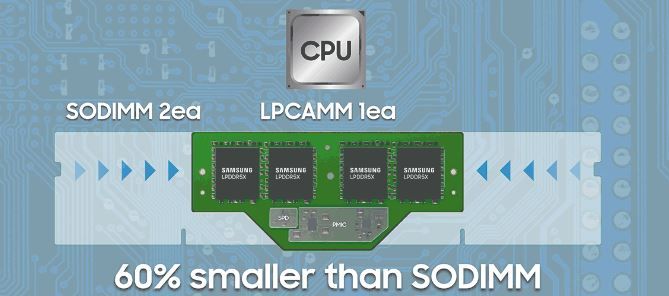
Laptop memory modules are set to receive a huge upgrade with LPCAMM2. It’s a new RAM technology that is more compact and energy-efficient than legacy SODIMM RAM modules. LPCAMM2 is also said to introduce huge performance improvements in portable devices like laptops and bring higher flexibility with its user-replaceable design.
In this guide, let’s understand LPCAMM2, discuss its pros and cons, and explore the applications of this new RAM innovation.
What is LPCAMM2 memory?
LPCAMM2 stands for Low-Power Compression Attached Memory Module 2, a new RAM module designed for laptops. It uses the LPDDR5/X, which is currently one of the fastest RAM standards. They support speeds of up to 7500 MT/s, essential for performance-oriented laptops.
This new RAM is extremely compact, which also makes it more energy-efficient. While most laptops do not allow replacing the RAM, LPCAMM2 is designed to be user-replaceable where you can easily swap the physical RAM module. This makes upgrades and repairs easier.
LPCAMM2 is also officially certified and recognized by the Joint Electron Device Engineering Council (JEDEC), making it a global standard. Hence, all OEMs can easily adopt the new standard to produce LPCAMM2 RAMs for portable devices.
LPCAMM2 vs SODIMM
The primary difference between the two is that LPCAMM2 is smaller by 60%, compared to SODIMM. Considering laptops have become thinner with the rising popularity of the notebook form factor, using small-sized components is the need of the hour. Hence, LPCAMM2 will be the preferred choice of OEMs, as it leaves more free space inside the laptop.

SODIMM is a compact form factor of DIMM that is used in desktops. It is also user-replaceable just like LPCAMM2. However, it is limited to DDR RAM modules, which consume relatively higher power than LPDDR-based RAM. This significantly affects the battery life of the laptop.
LPDDR and LPDDRX RAM are more power efficient and provide higher bandwidth than DDR-based RAM. However, they need to be soldered directly on the motherboard. This makes LPDDR-based RAMs difficult to repair, and impossible to upgrade. If you are wondering what these terms mean, here’s a simple explanation,
| Term | Full Form | What is it? | Function |
| LPCAMM | Low-Power Compression Attached Memory Module |
RAM Slot
|
To be used in upcoming laptops,
and other portable devices |
| SODIMM | Small Outline Dual In-line Memory Module |
Used in laptops as
user-replaceable RAM modules |
|
| DIMM | Dual In-line Memory Module |
RAM for Desktops
|
|
| LPDDR | Low Power Double Data Rate |
Type of memory
chips used in RAM |
Power efficient RAMs,
but soldered on the motherboard of laptops and smartphones |
| DDR | Double Data Rate |
Standard RAM technology
used in both laptops, mobiles, GPUs, etc. |
Note: The numbers followed by these abbreviations denote the generation and versions of that particular technology. For example: LPDDR4, LPDDR4X, LPDDR5, and LPDDR5X are different versions of LPDDR itself, where higher numbers mean newer generations.
Advantages of LPCAMM2
Since the latest RAM standards of LPDDR5 and LPDDR5X require the physical RAM chips to be soldered directly on the motherboard for faster and higher bandwidth with the CPU, they cannot be upgraded or repaired easily by the user.
LPCAMM2 solves this problem with its user-replaceable slot design. It also uses the latest LPDDR5/LPDDR5X-based memory chips, ensuring the best performance. To put things into perspective, LPCAMM2 uses the best RAM hardware while providing the flexibility to replace and repair easily.
Here’s a quick summary of the pros of LPCAMM2 over legacy laptop RAM technologies:
- Compact and needs less space than SODIMM-based RAM.
- Easily replaceable by the user.
- Provides faster speeds and higher bandwidth over SODIMM.
- Better thermal stability.
List of OEMs with LPCAMM2
Micron was the first OEM to produce LPCAMM2-based RAM. The company was shortly followed by Samsung. As of now, these are the only two OEMs with readily available LPCAMM2 RAM modules in the market, and Micron is currently leading in the segment.
Micron’s LPCAMM2 RAM are available under its Crucial brand. The company is producing 32GB and 64GB variants of this new RAM technology with speeds of up to 7500MT/s.
Micron and Samsung are actively working with laptop manufacturers to introduce LPCAMM2 RAM in laptops and other portable devices. The Lenovo ThinkPad P1 Gen 7 is the world’s first laptop to feature this new technology. According to Samsung, we can expect more laptops with LPCAMM2 slots by the end of 2024.
FAQs
Will LPCAMM replace SODIMM?
LPCAMM will not replace SODIMM. Instead, it will serve as a compact alternative for higher-end laptops that require faster and modular memory in a compact form factor. Currently, LPCAMM2-based RAMs are more expensive than SODIMM, hence budget and mid-range laptops are likely to continue using SODIMM or soldered RAM for a while.
Does LPCAMM improve gaming performance?
LPCAMM2 provides faster speeds of up to 7500 MT/s, which can aid gaming performance by a small margin. However, the benefits come due to the presence of LPDDR5/X-based memory chips. In general, the LPCAMM2 slot does not boost gaming performance directly by itself.
What is the purpose of LPCAMM2?
The main purpose of LPCAMM2 is to fit in smaller and more compact systems, without compromising on performance, while being easily replaceable. It combines the advantages of all previous RAM technologies (speed, form factor, and modularity).














